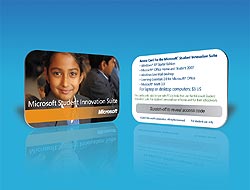BEIJING, April 19, 2007 – Microsoft made it clear today where the company is headed with regard to education: full speed ahead, and in all parts of the world.
Microsoft Chairman Bill Gates concluded Microsoft’s Government Leaders Forum (GLF) Asia conference by introducing the centerpiece in the company’s action plan to help transform educational opportunity around the globe. For five years, Microsoft’s Partners in Learning program has been nurturing and supporting the world’s most innovative teachers and schools, and later this year it will expand to incorporate new innovations for students with affordable licenses to mainstream Microsoft products and services. The new Microsoft Student Innovation Suite rounds out the company’s Partners in Learning program by adding an offer for governments that provide PCs directly to students in kindergarten through 12th grade.

Students from a village outside of Beijing, China, use Microsoft Student Innovation Suite to study together after school. February 2007.
The Microsoft Student Innovation Suite aims to open up new worlds of opportunity for students in lower-income and disadvantaged communities by making the software most universally used in education today – Microsoft Windows and Microsoft Office – available at a deep discount. Microsoft developed the innovation suite as a vital new commitment to its vision for education, which holds that all people of all ages should have the ability to realize their potential through access to high-quality educational opportunities.
To get the story behind today’s announcements, PressPass spoke with Orlando Ayala, senior vice president of Microsoft’s Emerging Segments Market Development Group; Gerri Elliott, corporate vice president of Microsoft’s Worldwide Public Sector organization, and Will Poole, corporate vice president of the company’s Market Expansion Group. Among other topics, the three executives explain how the creation of new products and programs – by Microsoft and its industry partners – can help bridge the gap in learning opportunities that exists today between developed and developing countries.
PressPass: What’s the significance of today’s announcement?
Orlando Ayala: We’re acutely aware of the digital divide that puts many young people at a disadvantage in terms of acquiring critical 21st-century skills. We hear this same concern expressed by the governments and education communities of developing countries, from Guatemala to Namibia to Thailand to India and China. These nations know their young people will benefit greatly from having access to modern computers equipped with complete, educationally relevant software solutions that they can use in their schools and homes. At Microsoft, we know that too. We also know that PCs for students need to be both highly capable and inexpensive. And to deliver real educational value on those PCs, the software has to be affordable and compatible with thousands of innovative education, productivity and communication applications available around the world.
For many years, our Partners in Learning program has enabled educational institutions to acquire deeply discounted genuine software for school PCs. It has also supported teacher training for the integration of technology into the learning process. Increasingly, however, we have heard from governments around the world that they are interested in putting technology directly into the hands of students through low-cost PCs, laptops and refurbished computers that the students may use at home and/or in the classroom. So today we’re making a bold commitment to help increase student access to technology for learning in an extremely affordable way through a new software suite, the Microsoft Student Innovation Suite. It’s our way of kick-starting the effort to bridge the digital divide in the education space.
PressPass: Who qualifies for the Microsoft Student Innovation Suite?
Will Poole: We recognize that making high-quality educational resources available with any degree of scalability is a huge challenge for the governments of developing nations. To address that challenge, we’re enabling governments in low-income countries to supply their students with a software suite assembled especially for learning, at a cost that’s exceptionally affordable.
Our Microsoft Student Innovation Suite offering is mostly about delivering affordable software to children in developing countries, and we expect the vast majority of orders for the suite to originate there. But we will also make it available through our Partners in Learning program to higher-income countries that have government programs designed to reach underserved communities, following our Partners in Learning guidelines. For example, the governments of the United States or western European nations could choose to subsidize PC purchases for specific underserved populations or disadvantaged inner-city schools and take advantage of the discounted software rate if they have a Partners in Learning agreement in place.
I should also point out that the individual components of the Microsoft Student Innovation Suite are already available to our existing customers and partners worldwide. This new offer is about getting the components assembled and priced to match the needs of the specific programs we’re hearing about from our partners in government institutions.

An Access Card for the Microsoft Student Innovation Suite.
PressPass: What software does the Microsoft Student Innovation Suite include, and how will you make it available?
Poole: The Microsoft Student Innovation Suite includes Microsoft Windows XP Starter Edition, Microsoft Office Home and Student 2007, Microsoft Math 3.0, Learning Essentials 2.0 for Microsoft Office, and Windows Live Mail desktop. It will be available at a nominal fee to governments purchasing bulk orders of computers for primary and secondary students. Through our Partners in Learning program, we will offer this suite for US$3, so we’re really intending this to help transform education in underserved student groups worldwide. The cost of the media is not included in this price. Governments can purchase the software suite on various types of distribution media through Microsoft “Authorized Replicators” and OEM [original equipment manufacturer] partners.
PressPass: How does this effort align with Microsoft’s current Partners in Learning offerings?
Gerri Elliott: This is an exciting extension of the work we’ve done over the past few years through our Partners in Learning program. The Microsoft Student Innovation Suite adds a compelling new government component to this program, which has traditionally focused on providing educational resources, tools and programs for schools and teachers.
For example, we offer an Innovative Teachers Network portal where teachers in specific geographies can benefit from collaborating on best practices, and we host a network of events around the world to connect award-winning teachers with their peers for training sessions and information-sharing on creative ideas. Partners in Learning has also focused on innovation at the school level. That involves things like looking holistically at education reform, best practices, how to implement project-based learning, how to usher in better ideas for taking the greatest advantage of technologies such as tablets and portals, and so forth. Other offerings already in place include the Fresh Start for Donated Computers Program and the School Agreement Program, which benefits schools in economic need by offering reduced pricing on software licenses.
This is where we see a great fit for delivering the Microsoft Student Innovation Suite, which rounds out our Partners in Learning program by adding a one-to-one student-focused offer that helps governments get involved. We’re finding that governments today are actively exploring the idea of subsidizing or giving computers to their students, whether those are inexpensive refurbished PCs, new laptops, Tablet PCs, or locally manufactured PCs targeted for use in educational settings. We see this brewing interest becoming more of a trend in the future, and we want to be ahead of the game with a Microsoft offering that’s highly beneficial for primary and secondary students. We hope to encourage governments to play a more active role in bringing students the benefits of technology by offering them an easy choice to make. That choice is the Microsoft Student Innovation Suite, coupled with the extensive ecosystem of third-party hardware and software providers that support Microsoft Windows and Office.

A first-grade student in Hanoi, Vietnam, uses Microsoft Student Innovation Suite to study away from school. February 2007.
PressPass: Are any governments financing PC purchases for students in developing countries or underserved communities today?
Ayala: Not that we know of at a large scale, at least not yet. But a lot of countries are considering and even piloting the concept, which is generally referred to as one-to-one computing. Governments and organizations are starting to explore the idea of enabling every person to have some sort of personal experience with technology, and that’s what our effort to deliver the Microsoft Student Innovation Suite is designed to do.
The timing is perfect for the environment today. Governments are focusing on information and communications technology as a way to help educate children and strive for better employability. In the least developed countries more than anywhere officials understand the importance of education and what that means for their young citizens, and they’re looking at how technology can help bridge those gaps. At the same time, hardware companies and OEMs are looking hard at ways they can bring down costs, and some manufacturers have begun delivering low-cost PCs and devices targeted to the needs of students. We asked ourselves how Microsoft could contribute to this moment in time. The answer is, we have one of the best educational software stacks out there, and local companies have innovated with additional applications and services that take advantage of our software. Now is the time – the right time – to deliver it in a way that’s affordable and encourages our government partners to take this leap for students.
PressPass: What’s Microsoft’s rationale for the $3 licensing?
Poole: It’s a case of philanthropy meets business. We view Unlimited Potential as a convergence that combines Microsoft’s long history of philanthropy and corporate citizenship with our focus on sustainable business practices. Unlimited Potential is about reaching the estimated 5 billion people who aren’t yet realizing the benefits of information technology. It reflects our long-term commitment to help digitally disenfranchised people achieve their full social and economic potential. We know it’s going to take lot of different efforts in different areas to make that happen. Some of those efforts will be philanthropic in nature while others will involve being creative on the business side, such as figuring out how we empower people to be customers in ways that fit the reality of their lifestyle.
It’s also important to note here that we’re not in this alone. Our efforts to extend the benefits of technology to the next 5 billion people depend on forging close ties with local governments, academic institutions, educators and community organizations, as well as engaging in collaborations with our industry partners. We work very closely with Intel’s World Ahead program, AMD’s 50/15 initiative, partners like UNESCO, worldwide development banks and many others. It’s a big challenge and it will take combined efforts to make real change in people’s lives, but that’s what we’re signed up to do. And we will do it in a way that is ultimately sustainable and good business for Microsoft as well.
PressPass: What do you expect to see in schools this year as a result of this new program?
Poole: It’s hard to say how fast the large-scale programs will roll out. As Orlando mentioned, there are already pilots happening around the world. None are happening at scale yet, though; we’re talking tens of thousands of units per year per country. The educational payback of this application of technology needs to be proven, and that will not happen overnight. And even as the new technologies are deployed to students and to teachers and classrooms, there’s new software to be developed to make the most of the underlying hardware. For example, we’re seeing innovative applications being developed to help students develop critical thinking skills, become better problem solvers and improve their writing. And there’s also a complex supply chain and support infrastructure to manage, as many target schools and students live in rural areas with limited resources for telecommunication, training and support.
I’m optimistic that some of the many pilot programs happening around the world today will result in the first truly scaled deployments, in the hundreds of thousands of units, within the next 12 months.

Juliana O. Cavalcanti of Recife Antigo, Brazil uses Microsoft Innovation Suite for her school work. January 2007.
PressPass: Bill Gates announced Unlimited Potential, the company’s commitment to help close the digital divide through a focus on education, fostering local innovation and enabling jobs and opportunities. Why is education such a key focus of Unlimited Potential?
Ayala: In the global information economy, the future prospects of individuals and entire nations rest on the quality of education available to them. With an educated citizenry, countries and industries flourish, people’s lives improve through access to better jobs, and the spark of innovation fosters continued human progress,
Microsoft does business in many countries, so we’ve seen a lot of firsthand evidence of the lack of parity in education opportunity. The most pressing issue — universal access to quality education — has also been documented by various development agencies. We’re seeing steady progress toward achieving many of the international “Education for All” (EFA) goals established by a broad coalition of national governments, civil society groups, and development agencies such as UNESCO and World Bank in 1990. But we continue to face serious challenges. For example, the World Bank estimates that about 77 million primary-school-aged children are not in of school today due to financial, social or physical barriers and pressures. Among secondary-school-aged children, as many as 50 to 70 percent are not in school in many countries. Governments around the world are looking to technology to help increase educational opportunity for their citizens, and we are ready to help.
A second urgent issue is the critical shortage of trained teachers. UNESCO estimates that 18 million new teachers will be needed between now and 2015 to reach Universal Primary Completion (UPE) goals. Meanwhile, also according to UNESCO, less than 40 percent of teachers in many emerging segments meet minimum qualifications. In addition to recruiting and training new teachers, we need to extend the reach of today’s great teachers to impact more students. We’re working on creative pilots like Digital Study Hall in India, where videotapes of outstanding teachers giving lessons are distributed to rural schools, to demonstrate how even a low level technology can extend the reach of a high- quality education.
Our experience in developing countries also highlights a third issue that drives the need for Unlimited Potential, and that’s the shortage of affordable and engaging learning content and services for learning at any age.
PressPass: Can you provide some examples of Microsoft’s education vision in action?
Poole: Our vision for education centers on enabling every individual to have unlimited potential to learn. This requires increasing access to education and empowering high-quality learning experiences, both of which lead to expanded social and economic opportunity.
Let’s take a look at the future. We imagine a time when every student has a personal device that he or she can use for learning activities throughout the day. Today, this might be an advanced cell phone or a low-cost laptop, but tomorrow it will be a powerful, wireless device that provides access to real-time learning services that students can access online, such as tutoring, as well as dynamic creativity tools that they can use, customize, and develop on their own. Students’ learning experiences will be highly personal, based on their individual learning needs, knowledge and skills. Their teachers will be able to easily customize their curriculum to meet the needs of every student so that all of them can learn to their full potential. Testing and assessment will be easy and continuous, making the teachers’ jobs easier, and enabling the local and regional school administration to see how well their students are advancing. All students and teachers will be part of a community of learners that includes their local classmates, and specialized instructors as well as regional and worldwide experts.
Stepping back from the future: a second aspect of our education vision is enabling the creation of high-quality learning experiences through applications and tools that enhance the learning environment. For example, Microsoft Research India developed Windows MultiPoint technology, which fosters collaborative learning in the classroom by enabling students to learn together using multiple mice with a single PC. A many-to-one relationship with PCs is the reality in the vast majority of even the most well developed schools today. The innovation here is enabling multiple mice with unique on-screen cursors to help move students from passive learning to active learning. Another here-and-now example is Microsoft Math, a collection of advanced tools and tutorials designed to help students succeed in math and science, from pre-algebra through calculus that also eliminates the need for an expensive graphing calculator used by many students. We have also seen many impressive third-party education applications designed for Windows. For example, Positivo Corporation has built their technology on Windows and developed E-Blocks, which employs a revolutionary, physical panel that makes it easy for students of all skill levels to interact with engaging multimedia software. Children identify letters, spell words, and build sentences by placing palm-sized blocks labeled with letters and symbols into the panel’s pockets.
Ayala: Unlimited Potential is at its essence about that connection and relationship between education, local innovation and ultimately jobs and opportunities. Employability is a massive problem that governments and their citizens are facing and it’s an area we think technology can help significantly. We’re working with the government in India and our partners to develop an Employability Portal to help close the huge gap that exists there between education and entry to the workforce. For example, despite the escalating demand for talented workers to fuel India’s booming IT industry, as many as three out of four engineering students graduate from college today without the full set of skills they need to get jobs. The portal will address this employability gap by enabling students to assess their current skills, identify gaps, such as business or communications skills, and take advantage of various training options and learning opportunities that will better qualify them for jobs. Equally important, the Employability Portal will help students find jobs by connecting them with companies looking to hire employees with the skills they’ve acquired. We think this is an innovative way to tackle the employability problem, and it’s a solution that might also have implications in other developing countries where people could use a hand moving up the economic ladder.




